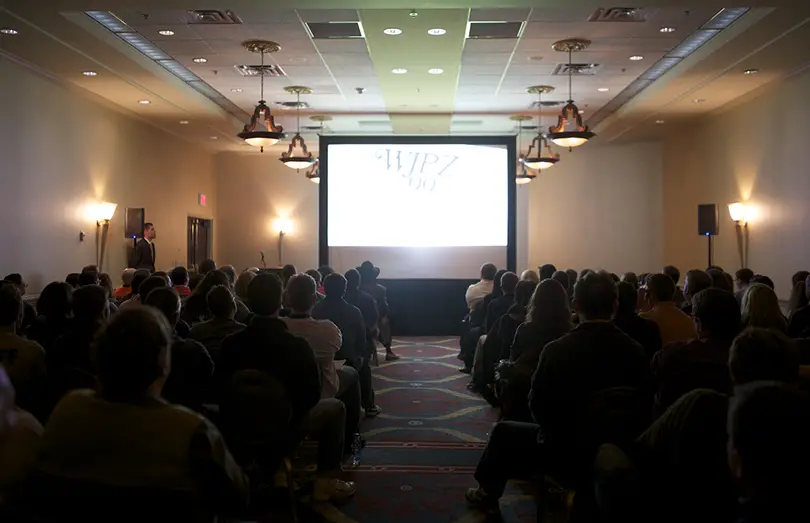And we’re back: WJPZ alumni gather for documentary on station’s history, hall of fame induction
With a voice tailor-made for a radio jockey, Bill Bleyle devoted the first few moments of his induction to the WJPZ radio station Alumni Association Hall of Fame — the same station he helped build by hand — to a Hunter S. Thompson quip.
“The radio business is a cruel and shallow money trench, a long plastic hallway where thieves and pimps run free and good men die like dogs,” Bleyle said, pausing long enough to let his punch line simmer.
“There’s also a negative side.”
But on a brisk Saturday afternoon in a swanky Sheraton Hotel room stuffed with WJPZ alumni — most with “Real Broadcasters Wear Orange” shirts draped over their shoulders — the radio business, or at least the WJPZ business, felt less like Thompson’s cruel-and-shallow money trench and more like a celebration of a radio station that’s always been in flux.
Around a hundred WJPZ alums flocked to the Sheraton Hotel on Saturday for a pair of reflective reunion events: the premiere screening of Scott MacFarlane’s “Greatest Media Classroom,” a half-hour documentary recollecting WJPZ’s ups-and-downs over 40 years of broadcasts, with founding fathers Bleyle and Greg Hernandez’s hall of fame inductions following right on the tail of the screening.
“It’s thirty minutes because as broadcasters, we know not to go too long,” MacFarlane, a 1998 alumnus, wisecracked as he introduced the documentary, a pet project of his that was described as both two years and 40 years in the making.
With snappy comedic timing, a lone jovial heckler called out, “This better be good,” in the quiet moments following MacFarlane’s remarks. Throughout the documentary, the audience swelled with laughter and applause, pointing out familiar faces and voices from vintage photographs and sound bites with cheers and the occasional pat on the back.
“Greatest Media Classroom” snapshotted the rollicking history of WJPZ, starting from its earliest iteration — the one Bleyle and Hernandez were there to remember. WJPZ was built with a 10-foot tall antenna perched atop Day Hall, a compressor purchased from an Army/Navy Store and $20 turntables.
“I walked up the steps to Day Hall to my old room on Day 7,” said Hernandez, a 1976 alum and WJPZ lifer, “and I remembered how that walk kept me skinny. It was a tremendous thrill to get to see buildings that were there when I was, and the new ones, too.”
The documentary marched through WJPZ’s story at a torrid clip, covering struggles with the university, the quest to land a coveted spot on the FM dial and some alternative outcomes for the station: WJPZ could’ve easily become WOJZ or WWJZ during the switch to FM, and during its AM days, Z89 was 10 spots higher on the dial than its now-familiar call number.
The audience’s constant interactions with both each other and the screen stilled during a segment about the station’s coverage of the Pan Am Flight 103 tragedy. The film also commemorated the loss of WJPZ broadcaster Steven Berrell, who was aboard the plane.
The mood lifted again as “Greatest Media Classroom” chronicled the station’s evolution through modern changes in technology, and a collective “aww” rose from the audience from a particularly sentimental segment about alumni getting hitched post-Z89.
MacFarlane’s documentary was met quickly with a loud and long standing ovation. Alumni like Danno Wolkoff, who started at the station in 1983 before graduating from Syracuse University in 1986, waxed nostalgic about their time spent in the studio.
For Wolkoff, a career in radio was an afterthought — until working at Z89 nudged him toward thinking that radio might be something he wanted to do post-graduation.
“I lived in Marion, and a friend asked me to be on his show,” Walkoff said, “The station gave me my life. It was absolutely phenomenal to see, just to be a small piece of that puzzle.”
During his induction speech, Bleyle noted how the station “started with sparks that turned into flames,” a nod to the nickname Z89 students of the late ‘80s earned from music press: “flamethrowers.”
Hernandez, who mentioned embracing Syracuse’s winter weather to walk around campus and reminisce, said it was astounding to see the completely revamped studio, missing the vinyl and reel-to-reels he was so accustomed to working with during his WJPZ tenure.
“This generation is still keeping the broadcast light on. Looking back, I see the same spark we had in students who are doing this today,” he said.
“Greatest Media Classroom” bottled WJPZ’s history in a 30-minute runtime, but so did the Comstock Room in the Sheraton for a Saturday afternoon, bringing together the same sense of history the documentary did.
Said MacFarlane when the credits stopped rolling: “Now all we need is a sequel.”
Published on March 3, 2014 at 2:00 am
Contact Erik: [email protected] | @therealvandyman






